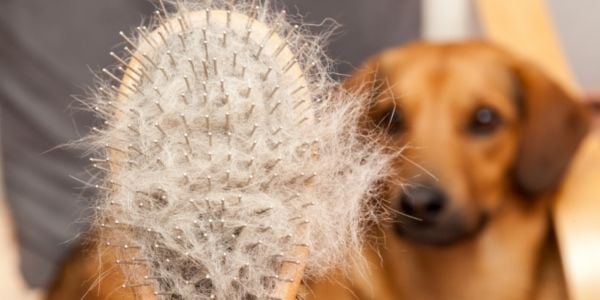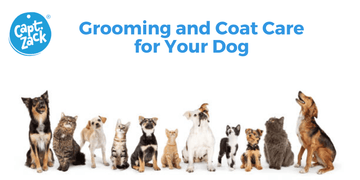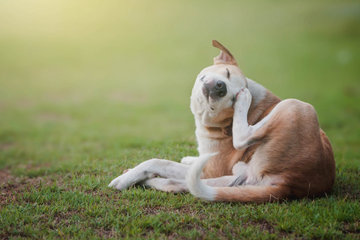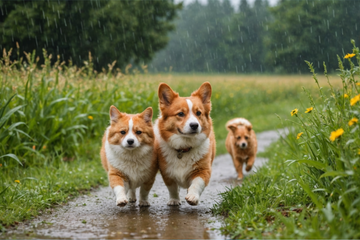By Tammy Hunter, DVM; Cheryl Yuill, DVM, MSc, CVH
Care & Wellness, Pet Services
The general condition of your dog's skin and coat are good indicators of its health. Although health and nutrition influence the lustre and texture of your pet's coat from the inside, regular grooming and skin care on the outside will help keep your dog's coat clean and free of tangles, no matter what type of hair coat he or she has.
What are the different types of hair coat that a dog might have?
Selective breeding has led to the development of dogs with a number of different coat characteristics and different grooming needs. Some breeds have hair that grows continuously and does not shed. These breeds require regular trips to the 'doggy salon' for a shampoo and cut. Breeds such as Siberian Huskies, Alaskan Malamutes, and many Retrievers have long, thick hair coats with both an outer coat of guard hairs and an undercoat of fine hair that serves as an insulating layer. These breeds often go through two heavy seasonal shedding cycles per year (late spring and late fall), during which much of the undercoat falls out in clumps. Many short-haired breeds lack a distinctive undercoat and these breeds often shed hair in low levels all year round.
How often should I groom my dog?
All dogs benefit from regular brushing to remove loose hairs and dead skin cells, to keep the coat free of dirt, debris, and external parasites, and to distribute natural skin oils along the hair shafts. Dogs with long, silky, or curly coats require daily brushing to keep their hair from becoming tangled or matted, especially around the ears, in the armpits, or along the back of the legs. Dogs with short hair coats may require less frequent brushing. However, daily brushing of any dog that sheds will cut down dramatically on the amount of loose hair and dog dander floating around the home, and will also cut down on the amount of hair that the dog swallows in the course of self-grooming with his tongue.

"All dogs benefit from regular brushing."
Regardless of the type of hair coat, you should inspect your dog's coat every day to make sure there are no tangles or clumps that have developed under the armpits, in the groin, or behind the ears. After a romp through the grass or in the woods, it is a good idea to look for burrs or twigs that might have become trapped in the coat and could potentially cause irritation.
If you regularly check your dog's coat and skin, you will also have a better chance of detecting any unusual lumps or bumps, parasites such as fleas and ticks, or areas of sensitivity on your dog's body.
What type of brush or comb should I use?
Different styles of brush work better on certain types of hair coats. Slicker brushes work well for dogs such as Poodles, with curly non-shedding coats, while combs or stiff bristle brushes are good for dogs with medium length hair that sheds, such as Retrievers. Brushes with short bristles or flexible grooming gloves are good for smooth-coated dogs such as Pointers or Boxer Dogs. Long-toothed combs, especially ones made with several offset rows, are good for use in dogs with long hair, such as Collies; these combs are also useful for removing tangled clumps of hair or for removing clumps of loose undercoat hair when your dog is undergoing a seasonal shedding.
Your breeder or groomer will have specific recommendations for a grooming tool that will work particularly well for your dog's type of coat. Whatever the choice of brush you use, it is important to be gentle when using it and to avoid excessive pulling on tangles.
How should I remove tangles or burrs?
If a tangle is small or relatively minor or if your dog has just picked up a burr or twig, you may be able to gently remove it by brushing or combing it out. If, however, the tangle is extensive or there is a large clump of burrs or grass awns forming a mat, it may be necessary to cut out the clump of hair. In this case, you need to be extremely CAREFUL that you do not accidentally cut your dog's skin. When tangles are severe or extensive, we strongly recommend that you seek professional care, either from a dog groomer or from your veterinarian. If a matt has caused any sort of skin irritation, take your dog to your veterinarian so that the appropriate treatment can be prescribed.

If you are planning on bathing your dog, make sure that you brush out as many burrs or tangles from the coat BEFORE bathing, since tangles can become impossible to remove after a bath!
How often should I bathe my dog?
Most dogs require bathing on an occasional basis, usually when their coat becomes dirty or when they develop a 'doggy odor'. Non-shedding breeds that have no health issues usually need to be bathed about every six to eight weeks. Dogs that have a heavy undercoat will benefit from bathing in the spring or fall, when they are undergoing their seasonal shedding.
"Most dogs require bathing on an occasional basis, usually when their coat becomes dirty or when they develop a doggy odor."
How often your individual dog needs to be bathed will vary somewhat with its age, lifestyle, type of hair coat, and underlying health. If you have a young puppy that is just being house-trained and he accidentally soils himself, there is no question that he should be bathed immediately. A dog that enjoys running through puddles or jumping into water may need a bath after a stroll through the mud or a romp in a dirty pond. Some dogs enjoy rubbing their head in decomposing debris in the park or rolling in objectionable objects and will need a bath to be allowed back into the house! Finally, if your dog has allergies, your veterinarian may prescribe frequent bathing as part of the treatment regime - with some of these dogs, daily bathing may be necessary until the problem is under control.
If you find that your dog requires frequent bathing, discuss this with your veterinarian who may recommend the use of a special shampoo, conditioning rinse or 'dry shampoo' to prevent skin problems associated with the repeated baths.
Can I use baby shampoo?
No. Dogs should only be bathed in a shampoo that is formulated for use on dogs - their skin has a different thickness and pH (acidity) than human skin. Human shampoo, including baby shampoo, is far too harsh for their skin. For regular bathing, a hypoallergenic shampoo without any added perfumes is the best choice.

Choose from Captain Zack's Complete Pet Grooming Range. Here!
How should I bathe my dog?
You should always bathe your dog in warm water, partly for the comfort of the dog and partly because shampoos clean more effectively in warm water. Depending on the dog's size, you may find that it is convenient to bathe him in the laundry tub or the bathtub or even in a walk-in shower stall. The common habit of washing dogs under the garden hose, using cold water, is not recommended, and is often the reason why dogs dislike being bathed.
"Make sure you read the instructions on the shampoo label."
After you have applied the shampoo, work it through the entire coat to remove all dirt and debris. Some owners of dogs with particularly thick coats find that it is best to dilute the shampoo in some water so that it is easier to apply and rinse out. For routine bathing, you can rinse the shampoo out right away, but if you are using a medicated shampoo, it must be allowed to sit on the coat for 5-10 minutes before being rinsed out (for more information on bathing your dog with medicated shampoo, see handout "How to Bathe Dogs with Medicated Shampoo"). Make sure you read the instructions on the shampoo label for the specific product that you are using or follow your veterinarian's directions if you are using a medicated shampoo.
Once the shampoo has done its job it must be completely rinsed out. For best results, a conditioning product should be applied afterwards to restore any lost moisture to the skin and minimize the development of dandruff after the bath.
Should I have my long haired dog shaved down in the summer?
Dogs with long hair may be more comfortable if their coat is cut short for the summer, depending on the circumstances. If you do cut your dog’s haircoat, it is important to leave at least 1” (2.5 cm) of haircoat on your dog to avoid sunburn or sun damage to the skin. Speak to your groomer or veterinarian to determine what is best for your dog’s haircoat and comfort.

Are there any final recommendations?
Your take home message is that your dog’s general coat appearance may be the first indicator of health problems. A healthy animal will not shed excessively and will have a shiny coat that is free from dandruff or greasiness. Before reaching for the bottle of shampoo, think about whether that lackluster coat could be telling you something else. If you have any concerns, contact your veterinarian for a consultation.





